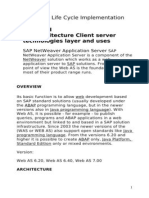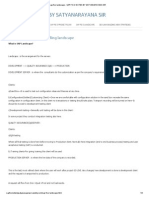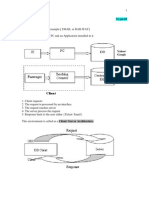Sap General Notes
Sap General Notes
Uploaded by
Mani kantaCopyright:
Available Formats
Sap General Notes
Sap General Notes
Uploaded by
Mani kantaOriginal Title
Copyright
Available Formats
Share this document
Did you find this document useful?
Is this content inappropriate?
Copyright:
Available Formats
Sap General Notes
Sap General Notes
Uploaded by
Mani kantaCopyright:
Available Formats
SAP R/3 is based on a 3-tier Client-Server model, run on three different
machines.
Database Layer
Application Layer
Presentation Layer
The Database Layer consists of an RDBMS (Relational Database
Management System), which accepts the database requests from the
Application Layer, and sends the data back to the Application Layer, which
in turn passes it on to the Presentation Layer.
The Application Layer or the server interprets the ABAP/4 programs,
receiving the inputs from them and providing the processed output to them.
The Presentation Server or ‘Presentation Layer’ is what is installed on the
typical workstation of a user. This is nothing but the SAPGUI, which when
started provides the user with the interface of SAP R/3 menus. This
interface accepts the inputs from the user, passes them on to the
Application Server, processes the inputs and sends back the output. If
database processing is required, the Application Server sends the details to
the Database Layer, receives the data, and then processes it at the
Application Layer level and sends back the output to the Presentation
Layer where the SAPGUI may format the data before displaying it on the
screen
What is an ‘Instance’?
An ‘Instance’ is an administrative unit that groups together components of
an SAP R/3 system or
simply an Application Server, which has its own set of work processes.
A Client can contain many instances.
The ‘System Landscape,’ in SAP, refers to a number of systems and their
deployment within an
SAP installation.
The ‘IMG (Implementation Guide)’ in SAP provides you with the various
configuration steps in a tree-like structure for easy access with the nodes at
the bottom representing the configuration objects.
The IMG is structured and arranged into four major logical groups:
1. General Settings (Country settings, currencies, calendar maintenance,
time zones, field display characteristics, etc.)
2. Enterprise Structure (Definition, assignment, consistency check, etc.)
3. Cross-Application Components (ALE, Time sheet, CATT, CAD
integration, Document Management, EDI, Engineering Change
Management (ECM), etc.)
4. Functional Area Settings (FI, CO, Logistics, PP, PM, QM, etc.)
Types of img
The Enterprise IMG is usually an exact copy of the ‘SAP Reference
IMG,’ but limited to the countries where the implementation is carried
out.
From the Enterprise IMG, you may create your Project IMG,
It is also possible to create the Project IMG by directly generating it
from the SAP Reference IMG.
In this case, the country selection is done when the Project IMGs are
created.
You might also like
- Learn SAP Basis in 1 Day: ALL RIGHTS RESERVED. No Part of This Publication May Be Reproduced orDocument16 pagesLearn SAP Basis in 1 Day: ALL RIGHTS RESERVED. No Part of This Publication May Be Reproduced orAaditya Gautam100% (2)
- Volte WPSDocument24 pagesVolte WPSEfebmas 123No ratings yet
- LTBC Website Project DocumentationDocument49 pagesLTBC Website Project DocumentationAntonio Acute Aka100% (1)
- Ab1001 - R/3 Overview & Architecture - V1.0: India Sap Coe, Slide 1Document46 pagesAb1001 - R/3 Overview & Architecture - V1.0: India Sap Coe, Slide 1Gaurav BansalNo ratings yet
- Understanding The Types of Work Processes in Application ServerDocument11 pagesUnderstanding The Types of Work Processes in Application ServerKapil Satish PatilNo ratings yet
- Learn SAP Basis in 1 Day: ALL RIGHTS RESERVED. No Part of This Publication May Be Reproduced orDocument16 pagesLearn SAP Basis in 1 Day: ALL RIGHTS RESERVED. No Part of This Publication May Be Reproduced orAnasNo ratings yet
- PI Overview1Document185 pagesPI Overview1Diwakar ChinthaNo ratings yet
- RAVIDocument6 pagesRAVIraveegillalaNo ratings yet
- SAP R3 ArchitectureDocument5 pagesSAP R3 Architectureapi-3824295100% (2)
- R/3 Architecture Client Server Technologies Layer and Uses: SAP R/3 Full Life Cycle ImplementationDocument148 pagesR/3 Architecture Client Server Technologies Layer and Uses: SAP R/3 Full Life Cycle ImplementationsajidsfaNo ratings yet
- Ab1001 - R/3 Overview & Architecture - V1.0: India Sap Coe, Slide 1Document42 pagesAb1001 - R/3 Overview & Architecture - V1.0: India Sap Coe, Slide 1Sreedhar KonduruNo ratings yet
- S1 Introduction To SAP Basis - 1 PDFDocument6 pagesS1 Introduction To SAP Basis - 1 PDFSooraj RautNo ratings yet
- Sap BasisDocument5 pagesSap BasisRubina SharmaNo ratings yet
- Abap NotesDocument4 pagesAbap NoteszafadraNo ratings yet
- Introduction To SapDocument24 pagesIntroduction To SapAmit NagaichNo ratings yet
- History of SAP R/3Document3 pagesHistory of SAP R/3nileshvp4841No ratings yet
- Sap Fico Landscape - Sap Fico Notes by Satyanarayana SirDocument3 pagesSap Fico Landscape - Sap Fico Notes by Satyanarayana SirManjunathreddy SeshadriNo ratings yet
- SapDocument10 pagesSapUzair ShakeelNo ratings yet
- 01 - OverviewDocument35 pages01 - OverviewKlever MadrizNo ratings yet
- XI Tutorials PDFDocument135 pagesXI Tutorials PDFtatialbernazNo ratings yet
- What is ERPDocument144 pagesWhat is ERPpankajbharneNo ratings yet
- 2.1 SAP System Architecture: Chapter ExcerptDocument4 pages2.1 SAP System Architecture: Chapter ExcerptShiva VydulaNo ratings yet
- SAP R3 ArchitectureDocument2 pagesSAP R3 Architecturejithendra prasa allaNo ratings yet
- 1 Introduction To SapDocument11 pages1 Introduction To SapGaurav ChaudhariNo ratings yet
- Sap Architecture Interview QuestionsDocument5 pagesSap Architecture Interview Questionsramya0% (1)
- SAP Basics For Beginners-FAQsDocument63 pagesSAP Basics For Beginners-FAQsdurendranNo ratings yet
- Sap Basis FileDocument73 pagesSap Basis FilePulkit JainNo ratings yet
- Project XYZ: - by J GanDocument15 pagesProject XYZ: - by J GanJayNo ratings yet
- Releases: SAP R/3 Is The Former Name of TheDocument4 pagesReleases: SAP R/3 Is The Former Name of TheDinesh TiwariNo ratings yet
- What SPRO Stands ForDocument7 pagesWhat SPRO Stands ForDisha Bandi50% (2)
- SAP - ArchitectureDocument5 pagesSAP - Architecturevikash bhushanNo ratings yet
- Sap Over ViewDocument11 pagesSap Over ViewNoopur KashyapNo ratings yet
- SAP FICO MaterialDocument149 pagesSAP FICO MaterialsholasNo ratings yet
- 2 Krish AbapDocument2 pages2 Krish Abapkrish9.900000No ratings yet
- SAP UnifierDocument4 pagesSAP UnifierRajeshNo ratings yet
- Closing Cockpit SAPDocument8 pagesClosing Cockpit SAPPratik Kakadiya0% (1)
- Sap QN Ans - 2Document14 pagesSap QN Ans - 2vsdsNo ratings yet
- Sap NetworkDocument135 pagesSap NetworkharishNo ratings yet
- Sap BasisDocument114 pagesSap BasisVamshikrishna ChityalaNo ratings yet
- GlossaryDocument6 pagesGlossaryEnver BalıkçıNo ratings yet
- ABAP 1000 Solved QuestionsDocument34 pagesABAP 1000 Solved Questionssujit2k7No ratings yet
- Sap BasisDocument174 pagesSap Basisnaren2899100% (1)
- Advantages of ERP: Enterprise Resource Planning (ERP) Is A Category of Business-Management SoftwareDocument11 pagesAdvantages of ERP: Enterprise Resource Planning (ERP) Is A Category of Business-Management SoftwarenagarajuNo ratings yet
- Process Integration (PI) : PurposeDocument20 pagesProcess Integration (PI) : PurposeAvijit RoyNo ratings yet
- Introduction To SAP J2EE: Development and Extension Guide - SAP E-Commerce 5.0Document9 pagesIntroduction To SAP J2EE: Development and Extension Guide - SAP E-Commerce 5.0Srinivas Ayyala SomayajulaNo ratings yet
- 1000 SAP ABAP Interview Questions and AnswersDocument32 pages1000 SAP ABAP Interview Questions and AnswersMuni ChandranNo ratings yet
- Sap Architecture NewDocument13 pagesSap Architecture NewSanthosh MenonNo ratings yet
- Project Report On Development of Business Report Using ABAP ProgrammingDocument31 pagesProject Report On Development of Business Report Using ABAP ProgrammingAli KhanNo ratings yet
- Coale Ale 171Document14 pagesCoale Ale 171rgil252No ratings yet
- SAP Basis EBOOK PDFDocument362 pagesSAP Basis EBOOK PDFblackgoldboy50% (2)
- SAP interface programming with RFC and VBA: Edit SAP data with MS AccessFrom EverandSAP interface programming with RFC and VBA: Edit SAP data with MS AccessNo ratings yet
- Java / J2EE Interview Questions You'll Most Likely Be AskedFrom EverandJava / J2EE Interview Questions You'll Most Likely Be AskedNo ratings yet
- Siebel Incentive Compensation Management ( ICM ) GuideFrom EverandSiebel Incentive Compensation Management ( ICM ) GuideNo ratings yet
- SAS Programming Guidelines Interview Questions You'll Most Likely Be AskedFrom EverandSAS Programming Guidelines Interview Questions You'll Most Likely Be AskedNo ratings yet
- ASP.NET For Beginners: The Simple Guide to Learning ASP.NET Web Programming Fast!From EverandASP.NET For Beginners: The Simple Guide to Learning ASP.NET Web Programming Fast!No ratings yet
- NumPy TutorialDocument1 pageNumPy Tutorialahmed salemNo ratings yet
- Lab Manual: Sub: Software Engineering Lab (6KS07) Software Engineering Lab 6KS07 Software Engineering Lab P-2, C-1Document11 pagesLab Manual: Sub: Software Engineering Lab (6KS07) Software Engineering Lab 6KS07 Software Engineering Lab P-2, C-1Computer Science & Engg, PusadNo ratings yet
- ch10QTE v7Document18 pagesch10QTE v7wabiinafNo ratings yet
- w564 Ny-series Industrial Pc Platform Troubleshooting Users Manual en (1)Document800 pagesw564 Ny-series Industrial Pc Platform Troubleshooting Users Manual en (1)Asep Muliana IbrahimNo ratings yet
- First Fit,Next Fit ,Best Fit ,Worst FitDocument4 pagesFirst Fit,Next Fit ,Best Fit ,Worst FitWeb EngineerNo ratings yet
- Shadowsocks VPN Script PythonDocument8 pagesShadowsocks VPN Script PythonGurban BabayewNo ratings yet
- M ANANDA FAUZAN, Selo, S.T., M.T., M. SC., PH.D I Wayan Mustika, S.T., M.Eng., PH.DDocument2 pagesM ANANDA FAUZAN, Selo, S.T., M.T., M. SC., PH.D I Wayan Mustika, S.T., M.Eng., PH.DM Rizki AsriyandaNo ratings yet
- Project IdeasDocument6 pagesProject IdeasSidraKhanNo ratings yet
- Artificial Intelligence Lab FilesDocument13 pagesArtificial Intelligence Lab FilesJhonNo ratings yet
- Assignment 1 Report: Name: Manuja Sellahewa Student ID: Lab Class: Teacher:Miss - Lushaka NissansalaDocument9 pagesAssignment 1 Report: Name: Manuja Sellahewa Student ID: Lab Class: Teacher:Miss - Lushaka NissansalamanujasellahewaNo ratings yet
- Dell EMC PowerEdge Modular - Servers - (Blade) M640 Spec SheetDocument2 pagesDell EMC PowerEdge Modular - Servers - (Blade) M640 Spec SheetPaulo Victor SilvaNo ratings yet
- iDE - 1.0.2 - User's ManualDocument9 pagesiDE - 1.0.2 - User's ManualaillNo ratings yet
- RPS E - CommerceDocument20 pagesRPS E - CommerceElias KetarenNo ratings yet
- 2015 en GPSSpoofingofUav YuanJianDocument22 pages2015 en GPSSpoofingofUav YuanJianberbra kamelNo ratings yet
- PreviewDocument9 pagesPreview陶金No ratings yet
- Quick Setup Guide For PVR8130 and PVR7100Document12 pagesQuick Setup Guide For PVR8130 and PVR7100Emilio velázquezNo ratings yet
- ECE365 Exam Mar2012Document10 pagesECE365 Exam Mar2012locoNo ratings yet
- Kaushik Pasi - CVDocument5 pagesKaushik Pasi - CVameya vashishthNo ratings yet
- A 860kHz Grounded Memristor Emulator CircuitDocument11 pagesA 860kHz Grounded Memristor Emulator CircuitclionpoorNo ratings yet
- The Discussion Over Artificial IntelligenceDocument2 pagesThe Discussion Over Artificial IntelligenceEmmy LoversNo ratings yet
- Distance Learning Module in CSS10Document5 pagesDistance Learning Module in CSS10cecilmatis8No ratings yet
- Vidya SQL Internal Query TestDocument3 pagesVidya SQL Internal Query TestVidhya hsNo ratings yet
- Lab Assignment For Group A and Group BDocument9 pagesLab Assignment For Group A and Group BAshutosh DhokNo ratings yet
- E104-BT5040U User Manual: nRF52840 USB-Type Bluetooth ModuleDocument15 pagesE104-BT5040U User Manual: nRF52840 USB-Type Bluetooth ModulePhOeNiXNo ratings yet
- AI UT Paper 22-23Document2 pagesAI UT Paper 22-23Divyanshu Ranjan SinghNo ratings yet
- Acknowledgements To: M M Raiker, Computer Graphics Using Opengl, Filip Learning/ElsevierDocument65 pagesAcknowledgements To: M M Raiker, Computer Graphics Using Opengl, Filip Learning/ElsevierAmir RajaNo ratings yet
- Module 9: Address Resolution: Introduction To Networks v7.0 (ITN)Document15 pagesModule 9: Address Resolution: Introduction To Networks v7.0 (ITN)Mohmed11 GamalNo ratings yet
- Cable Tray Sizing ProgramDocument9 pagesCable Tray Sizing ProgramMohamad HarbeNo ratings yet

























































































